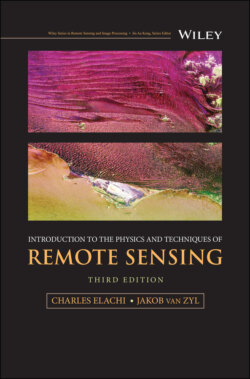Читать книгу Introduction to the Physics and Techniques of Remote Sensing - Jakob J. van Zyl - Страница 21
2.1.3 Wave Equation and Solution
ОглавлениеIn homogeneous, isotropic, and nonmagnetic media, Maxwell’s equations can be combined to derive the wave equation:
(2.7)
where ∇2 is the Laplacian. In the case of a sinusoidal field:
(2.8)
where
(2.9)
Usually μr = 1 and ∈r varies from 1 to 80 and is a function of the frequency. The solution for the above differential equation is given by:
(2.10)
where A is the wave amplitude, ω is the angular frequency, ϕ is the phase, and k is the wave vector in the propagation medium (speed of light in vacuum). The wave frequency ν is defined as ν = ω/2π.
Remote sensing instruments exploit different aspects of the solution to the wave equation in order to learn more about the properties of the medium from which the radiation is being sensed. For example, the interaction of electromagnetic waves with natural surfaces and atmospheres is strongly dependent on the frequency of the waves. This will manifest itself in changes in the amplitude (the magnitude of A in (2.10)) of the received wave as the frequency of the observation is changed. This type of information is recorded by multispectral instruments such as the LandSat Thematic Mapper and the Advanced Spaceborne Thermal Emission and Reflection Radiometer. In other cases, one can infer information about the electrical properties and geometry of the surface by observing the polarization (the vector components of A in (2.10)) of the received waves. This type of information is recorded by polarimeters and polarimetric radars. Doppler lidars and radars, on the other hand, measure the change in frequency between the transmitted and received waves in order to infer the velocity with which an object or medium is moving. This information is contained in the angular frequency ω of the wave shown in (2.10). The quantity kr − ωt + φ in (2.10) is known as the phase of the wave. This phase changes by 2π every time the wave moves through a distance equal to the wavelength λ. Measuring the phase of a wave therefore provides an extremely accurate way to measure the distance that the wave actually travelled. Interferometers exploit this property of the wave to accurately measure differences in the path length between a source and two collectors, allowing one to significantly increase the resolution with which the position of the source can be established or to measure slight displacements.
